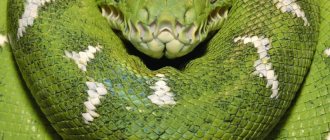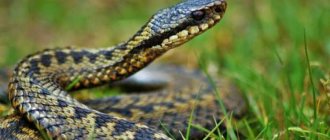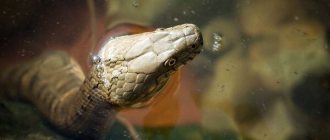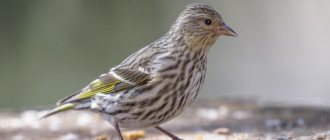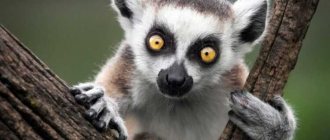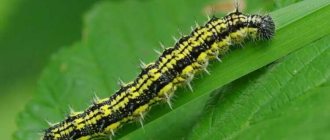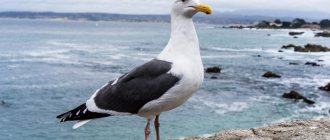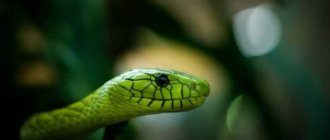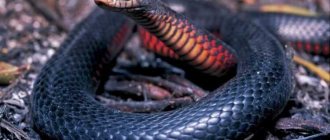Review author: “ZooVita”
Snakes are reptiles that are distributed throughout all areas, including harsh winter regions. But contrary to popular belief, not all adders are large in size. Some snakes can fit entirely in the palm of a child or teenager.
Small size does not mean that the reptile is not poisonous. Many small adders secrete strong hematological poisons when bitten. Photos of the smallest snakes will allow you to timely familiarize yourself with the phenotypic characteristics of each representative.
List of small venomous snakes
In the process of species development, representatives of this group of reptiles acquired specialized adaptations to protect themselves from attack. At the same time, the small size of the body is completely compensated by the concentration of the released toxin. The most famous small venomous snakes are:
- Efa.
- Viper.
- Arizona adder.
Each of the reptiles presented has a specific habitat and a number of specific external features that will allow you to recognize the reptile when you meet it. Often, it is the timely identification of the snake and its venom that makes it possible to provide specialized medical care.
Efa
Efa is a small poisonous snake. The body length barely reaches 30 cm (sometimes up to 50 cm, for some regions). Prefers to live in sand and roadside dust.
It settles mainly in regions with a hot climate, for example, in India, African countries, and a number of Arab countries. Efa is very aggressive, it can attack a person who disturbs it or crawl into clothes or shoes.
A detailed description will help you recognize the efu: a small head, sharply demarcated from the rest of the body. The skin color is dark gray or gray with light stripes on the sides.
The entire body of the reptile is covered with rows of scales. It is the noise produced by the friction of the scales that serves as a warning signal (for this effect the efa received the name “sawtooth snake”). The snake’s method of movement is also interesting: not in a straight line, but by squeezing and relaxing the body rings.
5 mg of epha poison can kill a person. The toxin has a pronounced hemolytic effect, so the bite is accompanied by severe bleeding from the resulting wound.
Viper
The efa's closest relative is the viper, which is also not very large. The smallest representatives reach a length of only 30 cm. A characteristic feature is the presence of fused scales between the eyes, which form a kind of shield.
Sometimes similar horny growths are present above the eyes, giving the vipers a very recognizable appearance. All species of vipers have two pairs of hollow fangs, which are designed to inject venom when bitten.
The effect of the poison can manifest itself both at the local level and at the level of the entire organism. The local reaction is manifested by swelling, redness, and severe pain. With a massive intake of toxin into the blood, chills, increased body temperature, dizziness and tachycardia occur. The venom of some members of the viper family is fatal.
Arizona adder
Another famous representative of poisonous snakes, which are small in size. When exhaling air from the lungs, it makes a characteristic popping sound. Attacks the victim if the scaring maneuver does not bring the desired result. The body length of the reptile does not exceed 40 cm.
You can recognize the Arizona adder by its specific coloring: contrasting alternation of red, yellow and black rings. The hollow fangs are curved anteriorly and can be recognized by their larger size. The asp is recognized as one of the most poisonous reptiles.
The released poison has a pronounced neurotoxic effect. Without specialized assistance within 24 hours, it causes complete paralysis of the respiratory muscles and cardiac arrest.
Pygmy viper
This venomous snake lives on the coast of Namibia and can also be found in loose sand dunes in the desert. This small, plump snake with heavily keeled scales feeds on small lizards and geckos. Moreover, during the hunt, it buries itself in the sand - only its tail and eyes remain on the surface. The victim, attracted by the sight of the tail, so similar to a larva, falls into an insidious trap. Prey under the influence of poison is immobilized and swallowed whole.
Along the steep slopes of shifting desert sands, the viper moves sideways, leaving behind zigzag marks on the sand. Snakes obtain moisture, which is so rare for the Namibian deserts, from their prey - lizards contain a lot of water. The condensation that forms on their body is also suitable as water.
Types of non-venomous small snakes
Among the huge variety of reptiles, there are also harmless varieties, for example, the following types of small snakes:
- Calamaria.
- Medyanka.
- Barbados narrowmouth snake.
The Barbados snake is officially recognized as the smallest snake in the world.
Barbados snake
The maximum body length of an adult reaches 10 cm. The reptile is absolutely harmless to humans. Due to the unusual structure of the oral apparatus, it feeds only on termites and small insects.
It likes to burrow into fallen leaves, where it is quite difficult to find even for an experienced observer. Outwardly it is very similar to a small worm. The body is pinkish in color, but the color can vary from brown to almost black. The snake is blind, and its eyes are covered with small shields.
Kalamaria
These miniature reptiles are found on the Philippine and Sunda Islands, and the island of Java. The maximum body length reaches 33 cm. The body has the same diameter and uniform color throughout. Representatives lead a hidden lifestyle, hide in earthen passages and are absolutely safe for humans.
Brahmin blind horse
The second known name for this very small snake is the potted reptile. The name is associated with the favorite settlement of snakes in the soil of flower pots. The body length of even an adult does not exceed 12 cm.
In terms of a number of anatomical features and lifestyle, it is very similar to earthworms (it digs soil well, helping to loosen it). The organs of vision are undeveloped, which determines the name of the representatives.
Striated wolftooth
The main representatives of this subspecies live in the countries of India and the mountains of Nepal. The maximum body size reaches 45 cm. There are two long fangs in the mouth, but the snakes are absolutely not poisonous.
After the bite, a small wound remains, which should be treated with an antiseptic solution (only bacterial infection can become a serious consequence). You can recognize a wolftooth by its characteristic skin color. There are transverse light stripes on a dark background.
Japanese already
On the islands of Japan, as well as in China, Korea and the Far East (RF), another representative of small snakes is widespread - the Japanese snake. The skin has a brown tint with an interesting olive tint. Leads a rather secretive lifestyle and is absolutely safe.
Leptotyphlops carlaec
When Dr. Blair Hedges set off on his next expedition to the islands of the Caribbean, he had no idea that he would return from his trip with an amazing discovery. Moreover, he did it completely by accident - after lifting one of the stones, he discovered the smallest snake that humanity has ever seen.
Under the neighboring stones, other representatives of this species were also found, mostly males; there were only two females. It is already known that the female lays one large egg, from which the baby hatches. Its dimensions are two times smaller than the mother's. Which is surprising in itself - in other species of snakes, the reproductive process follows a different scenario - expectant mothers lay at least a hundred eggs, from which snakes hatch ten times smaller than the parent one.
In any case, this new species, Leptotyphlops carlaec, has an advantage - such a large baby is maximally prepared for adult life. It's the same as if a human child were born weighing 30 kg and immediately went to high school.
As the discoverer himself suggests, this is due to the fact that if the newborn were several times smaller, he simply would not be able to find suitable food. The diet of the snake, whose length does not exceed 10 cm, consists of termite larvae and ants.
This is interesting: Long-tailed cat or margay
Photos of all types of small snakes
Common copperhead
These snakes can easily be found in Russia, or any other country on the Eurasian mainland. This type of snake is completely safe for humans, since their saliva does not contain any poison. Due to their small size (50-70 centimeters), they are often hunted by other predators.
Even though copperheads have no poison in their saliva, they are still very toxic to cold-blooded animals. Their saliva has a paralyzing effect, which allows the snake to hunt. Sometimes the copperhead can wrap itself around its prey to make it easier to hold. However, they do not strangle their victims; copperheads eat their prey alive.
Arizona adder
This 40 centimeter representative of the asp family is the smallest of all snakes of this species. But still, despite its miniature size, this snake is very visible to both humans and animals. This is due to the very bright coloring that this type of adder has.
This bright coloring is needed for a reason; it is a sign of its great toxicity. In general, in nature, all animals that have bright colors are dangerous to others. With the help of this color, the asp drives away enemies. In addition, this type of snake can make popping sounds that frighten animals. If it comes to fighting, the Arizona adder can even kill a person with its poison.
But, despite this, this type of snake is very calm, and almost always limits itself only to frightening sounds. However, it is better not to come close to them.
Reticulated python
A striking representative of this species lived in the Bronx Zoo and reached 7.5 meters in length. According to some reports, this is not the limit, and 10-meter individuals are found in the natural environment. The longest snakes on the planet live in the south and southeast of Asia, preferring tropical forests or mountainous hills. At the same time, they try to stay close to the water, being distinguished by their ability to swim beautifully. These snakes feed on small and medium-sized mammals; domestic animals often become their prey. Reticulated pythons are excellent hunters, their throwing speed is so fast that they can catch a bat or bird flying by. But they are not very good sprinters, so they attack the victim mainly from ambush. Attacks on people sometimes happen, but if you notice a python in time, then there is every chance of escaping from it.
Krayts
The most dangerous snakes on our planet can look harmless or even very beautiful. And a clear confirmation of this are the kraits. This genus of poisonous snakes has 12 species, among which the yellow-headed krait is considered the most poisonous. He has small teeth, but this is a dubious advantage in places where people wear light clothing.
Snakes of this species live on the islands of the Malay Archipelago, South Asia and Australia. They love dry places full of shelters, and often crawl into people's homes, as a result of which meetings of both occur quite often.
The average length of the edge is 1.5-2 meters. They are active mainly at night and at dusk, feeding on small mammals, lizards, amphibians and snakes.
Krayt is capable of killing 10 people with one dose of his poison. If you ask a reptile expert to name the ten most venomous snakes on the planet, he will definitely mention the krait.
Tame eirenis
Representatives of snakes are also small snakes. A photo of one of these can be seen below. This is a quiet eirenis. It got its name for its absolute non-conflict nature. Doesn't attack people, doesn't bite, and is actually docile.
The color of this snake varies within the following limits:
- gray;
- beige;
- brown.
There is a pattern on the head in the form of a light spot. With age, it darkens and merges with the rest of the body. The tail is very short compared to the body. Lives in:
- Iran and Iraq;
- Turkey;
- Azerbaijan;
- Georgia and Armenia;
- on the islands of the Mediterranean Sea.
During the winter it hibernates. It becomes active only in the evening; during the day it sleeps in bushes or rocky crevices. It can climb mountains to a height of over 1500 m. It is included in the appendix to the Red Book of Russia.
It feeds on insects and scorpions. Can eat centipedes and woodlice. Lays eggs by burying them in the ground.
Leaf-nosed Madagascar grass snake
Endemic to the island of Madagascar, the leaf-nosed Madagascar grass snake (Langaha madagascariensis) is found in deciduous dry and tropical forests. It is a medium-sized, very mysterious tree species. There is significant sexual dimorphism between males and females. The bite of this grass snake causes severe pain in humans, but is not fatal.
Sandy efa
The smallest snakes and the most dangerous are sand ephs. Representatives are small - only up to 60 cm in length. However, with such modest dimensions, the beautiful mobile snakes of this species are powerful killers. They are feared more than large spectacled snakes. Why?
The answer is simple - the bite of this individual is fatal. And for humans as well. Even if it is possible to remove the poison from the body in time and neutralize it, in most cases people remain crippled.
The worst thing is that the distribution area of efa is very large. It inhabits the lands of northern Africa, Persia, Algeria and adjacent territories, Turkey. Distributed almost as widely as the common viper in Eurasia.
Its body color varies from yellow, brown and cream. The snake is quite beautiful, since its entire body is decorated with patterns - spots, stripes, geometric patterns.
Another feature is live birth and the number of offspring - up to 16 pieces at a time! At the same time, snakes can reproduce even in winter, since they do not hibernate. Efa is a very mobile snake. When she sees danger, she makes characteristic rustling sounds, constantly jumps, wriggles and rushes in place.
Third place - black mamba
Black Mamba
The middle position of the top went to the black mamba, which is very dangerous and has a brutal character. Fortunately, it lives exclusively in Africa, so if you don’t go there, there’s nothing to be afraid of. But, when in Africa, you should always have an antidote with you. Since this relatively small snake is capable of moving at a speed of about twenty kilometers per hour. It is very difficult to escape from her if she notices you. Due to her instability, she hunts every living thing that comes into her field of vision.
If the mamba overtakes the victim and she resists, then she inflicts a series of bites (up to 12 in a row). This is despite the fact that the poison in one bite is enough to kill approximately twenty-five adults. Once in the blood, the neurotoxin immediately, from the first second, begins to affect all tissues
Best articles: Which spider is the largest on Earth - photos and descriptions of the largest spiders on the planet
This is why it is so important to have an antidote. You need to enter it within a few seconds, then there will be a chance to survive
Otherwise, death occurs after half an hour, maximum.
Striated wolftooth
This type of wolf-tooth can be found in India or Nepal. They are small in size, only 45 centimeters. Wolftooths do not have poison in their saliva, so they are harmless to humans, but their behavior is extremely aggressive. If you get too close to them, the wolf-tooths can attack, inflicting many bites.
They were nicknamed wolf-tooths because of the fangs that protrude from their faces. These fangs leave strong and deep bites. But, despite the excessive aggressiveness, this type of snake is very popular, because the coloring of these snakes is very beautiful. It can be divided into 2 types: camouflage under the environment, camouflage in the sand. But regardless of the type of coloring, wolf-tooths are in any case very beautiful.
Main differences
There are a number of signs by which you can distinguish a poisonous snake from a non-dangerous one:
in dangerous reptiles the head resembles a triangle and is clearly separated from the neck by an isthmus; in non-poisonous reptiles it is round or oval in shape and smoothly passes into the body; non-dangerous snakes have a round pupil, while in poisonous ones it resembles a vertical ellipse and looks like a cat’s; poisonous reptiles, as a rule, are brightly colored in contrast to non-dangerous ones; If a poisonous reptile opens its mouth, you will notice two fangs. Non-dangerous ones do not have these; in dangerous snakes, you can see heat-sensitive pits between the nostrils
Non-venomous snakes do not have them; The main characteristic of venomous rattlesnakes is the rattle tail; Non-dangerous reptiles have two rows of scales on their tail, while dangerous ones have one; if you see a snake swimming, you should know that only a poisonous one swims with its body on the surface of the water; If you can safely examine the snake, pay attention to the part of the tail behind the anus. In poisonous ones, it is the same as the whole body, while in non-toxic ones, a transverse pattern in the form of diamonds is visible; at the site of the bite of a poisonous reptile there will be points from two fangs, and only a scratch from a harmless one.
However, many rules have exceptions. In the case of snakes, there are the following:
- The coral adder has a round head, but is deadly. And some endangered, non-venomous reptiles flatten their heads into a triangular shape;
- There are a sufficient number of reptiles with bright colors, but they are not dangerous. And vice versa, in the middle and southern latitudes, poisonous snakes are inconspicuous and inconspicuous, their color blends with their habitat;
- such deadly snakes as mamba, taipan, and asp have round pupils, although they should resemble vertical slits.
Did you know? Some snakes may have three hundred pairs of ribs.
Reproduction
The Barbados thread snake reproduces by laying eggs. Moreover, females can lay no more than one egg during the breeding season. A baby reptile of this species is born with a length half the average length of an adult (about 5 cm). It is interesting that almost all species of small snakes are characterized by rather large dimensions of their offspring in relation to adult snakes. For comparison, it is worth saying that the cubs of large snakes are approximately 1/10 the size of adults. The eggs laid by small reptiles are also characterized by their large size compared to the parent. The egg of the Barbados thread snake has an elongated shape and is comparable to a grain of rice. Other snakes have more rounded eggs.
Japanese already
The Japanese snake is approximately fifty centimeters long. Body color is dark, closer to brown. Mouth in the form of a yellow stripe.
Note!
- Indian snakes: sacred, poisonous, most common and dangerous types of Indian snakes and their names (130 photos)
Snake bites - the most dangerous and poisonous snakes and the consequences of their bite (110 photos and videos)
Younger individuals are black. The habitat of the Japanese snake is forests with various trees and plants, meadows, and bushes. They are found in Japan, Primorye, Khabarovsk Territory, and Amur Region.
The Japanese snake feeds on worms, mollusks or frogs.
This is interesting: Sea cow: description, nutrition, behavior and disappearance
